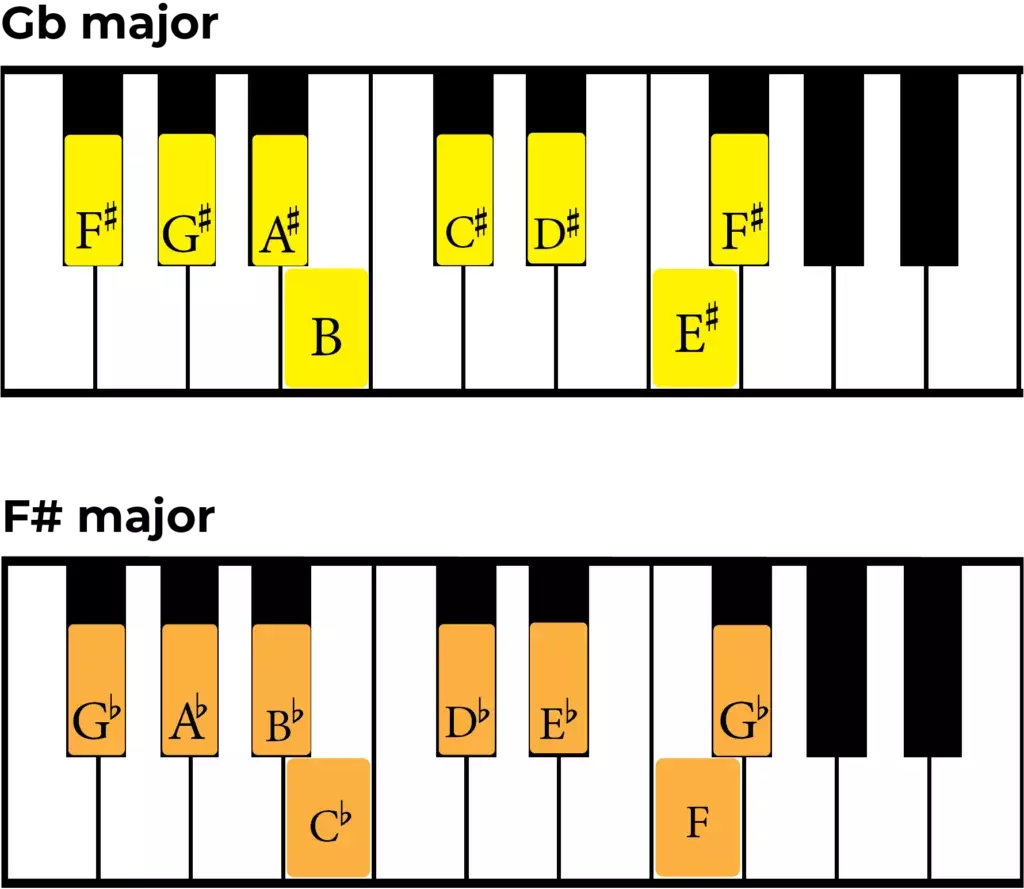Young or old, music beginners or advanced players, we sometimes question the location of specific keys on the piano. Today, we will demystify the keyboard and zero in on an often-used but infrequently discussed note: F sharp.

If you’ve ever struggled to find F# or just want to strengthen your piano knowledge, this article will be your comprehensive guide. We’ll provide step-by-step instructions to locate and play this subtle yet essential note effortlessly. Prepare to dive into the intriguing world of piano notes.
Contents
🎶Where is F Sharp on the piano?
The F sharp (F#) is found on the piano keyboard as the black key right after the white key F. To locate it, begin at the center of the piano, often called Middle C. From there, move one white key to the right (towards the higher end of the piano) to reach D.
Keep moving to the right, passing two more white keys, E and F. Immediately after the white key F, you’ll see three black keys. The first black key in this group is the F#.
So, in summary, on any standard piano keyboard, F# is the black key immediately to the right of any F key. Because the pattern of the piano keyboard repeats every 12 keys, you’ll find multiple F# keys across the full span of the keyboard.
🎶Is F-sharp the same as G flat?
Yes, F-sharp (F#) and G-flat (Gb) are the same notes on the piano, making them enharmonic equivalents. This means they represent the same pitch but have different names depending on the musical context they are used in.

On a piano keyboard, the F-sharp is the black key immediately to the right of the F key, while the G-flat is the black key immediately to the left of the G key. As it turns out, these descriptions point to the same black key.
The main reason behind having two different names for the same note is to maintain consistency with musical structure when writing or analyzing music. It allows composers and musicians to follow rules regarding key signatures and scales while adhering to the structure of chords, intervals, and harmony.
🎶Is F sharp above or below G?
F sharp (F#) is below G on a piano or any standard musical keyboard. When we say a note is “above” or “below,” we refer to its pitch, i.e., how high or low the sound produced by that note is. F# is the black key immediately before the white key G, which means it is a half-step or semitone lower in pitch. Therefore, F# is below G.
🎶What flat is equivalent to F sharp?
The flat equivalent to F sharp (F#) is G flat (Gb). These are regarded as enharmonic equivalents in music, meaning they have the same pitch but are named differently depending on the musical context. This dual naming allows consistency when writing or analyzing music, keeping with the rules regarding key signatures, scales, chords, intervals, and general harmony.
🎶How many F# Are there any on a piano?
On a standard classical piano, there are 88 keys. To determine the number of F# keys, we have to observe the repeating pattern of the piano keyboard. A full piano keyboard consists of 7 sets of 12-key patterns; each 12-key pattern has a group of two black keys and a group of three black keys.
Each 12-key pattern has one F# key, the first black key in the group of three black keys. Since there are 7 sets of 12-key patterns, there are 7 F# keys on a standard classical piano.
In summary, there are 7 F# keys on a standard classical piano, with each F# key contributing to a 12-key pattern that repeats throughout the piano.
You may also read: How much does it cost to restring a piano?
Conclusion:
F sharp (F#) plays a key role in understanding the structure and sound of music on the piano. As an enharmonic equivalent to G flat (Gb), it highlights the flexibility and nuance of musical language.
Positioned immediately to the right of F and the left of G, it’s a half-step lower pitch than G and is the first black key in the group of three within the repeated 12-key pattern on the piano. On a standard 88-key piano, F# appears seven times, a testament to its recurring significance across different octaves in music composition and performance.
